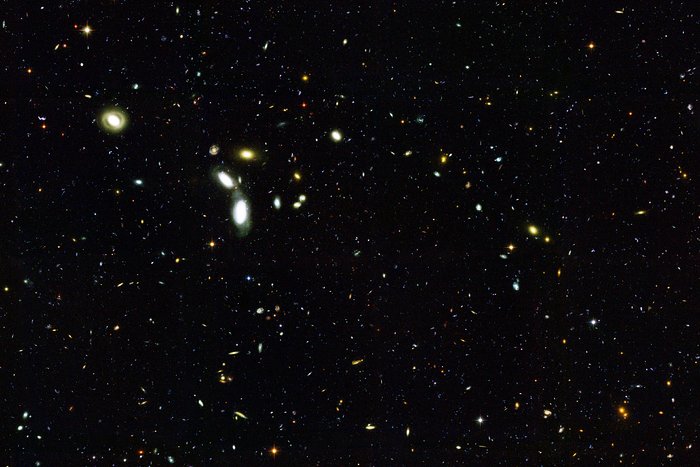Hubble Goes 'Deep' to Sample Young Galaxies
NASA/ESA Hubble Space Telescope reached back to nearly the beginning of time to sample thousands of infant galaxies. This image, taken with Hubble's Advanced Camera for Surveys, shows several thousand galaxies, many of which appear to be interacting or in the process of forming. Some of these galaxies existed when the cosmos was less than about 2 billion years old. The foreground galaxies, however, are much closer to Earth. Two of them [the white, elongated galaxies, left of center] appear to be colliding.
This image represents less than one-tenth of the entire field surveyed by Hubble. The full field, consisting of about 25,000 galaxies, is part of a larger survey called the Great Observatories Origins Deep Survey (GOODS), the most ambitious study of the early universe yet undertaken with the Hubble telescope. This survey targeted two representative spots in the sky - one in the Northern Hemisphere and the other in the Southern Hemisphere. This image represents the southern field, located in the constellation Fornax. The entire GOODS survey reveals roughly 50,000 galaxies. Astronomers have identified more than 2,000 of them as infant galaxies, observed when the universe was less than about 2 billion years old.
Credit:About the Image
About the Object
| Name: | HDF, Hubble Deep Field |
| Type: | Early Universe : Cosmology : Morphology : Deep Field |
| Constellation: | Fornax |
| Category: | Cosmology Galaxies |
Coordinates
| Position (RA): | 3 32 26.01 |
| Position (Dec): | -27° 44' 56.61" |
| Field of view: | 6.39 x 4.26 arcminutes |
| Orientation: | North is 20.4° left of vertical |
Colours & filters
| Band | Wavelength | Telescope |
|---|---|---|
| Optical B | 435 nm |
Hubble Space Telescope
ACS |
| Optical V | 606 nm |
Hubble Space Telescope
ACS |
| Infrared I | 775 nm |
Hubble Space Telescope
ACS |
| Infrared Z | 850 nm |
Hubble Space Telescope
ACS |


